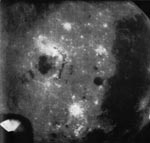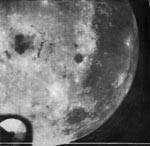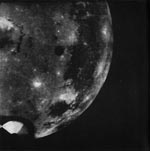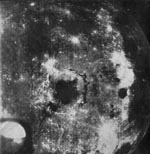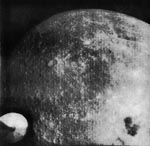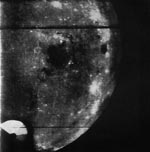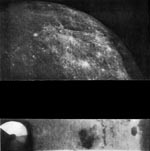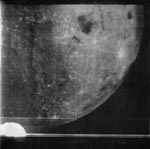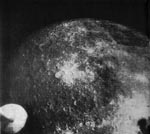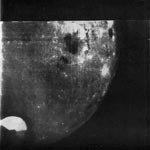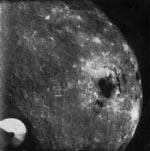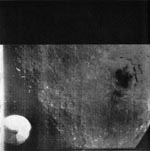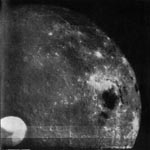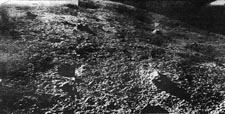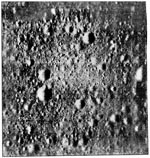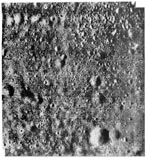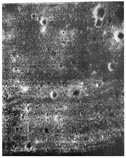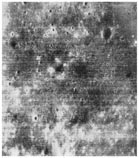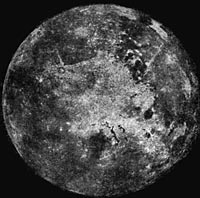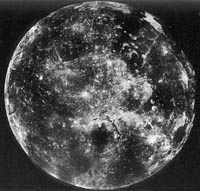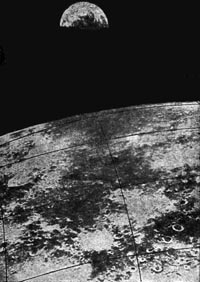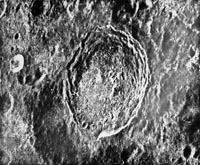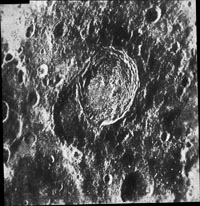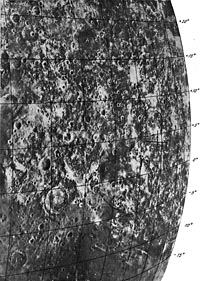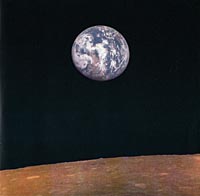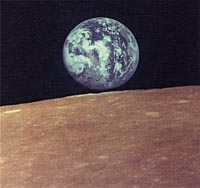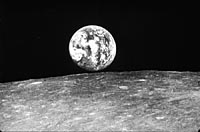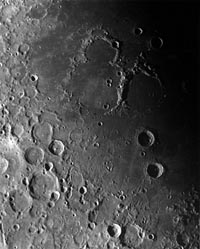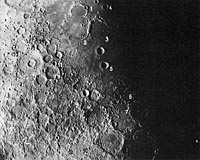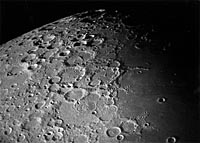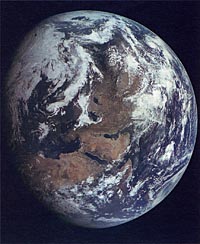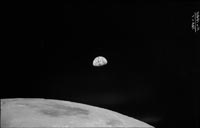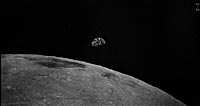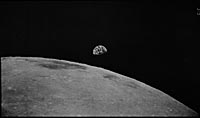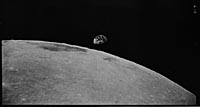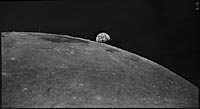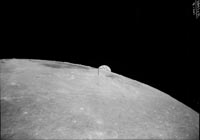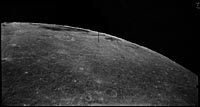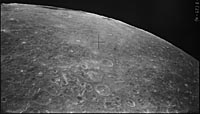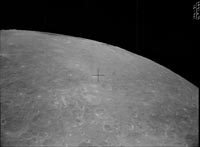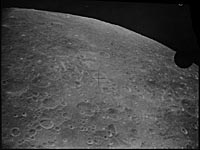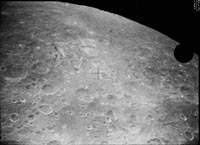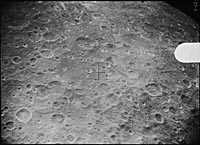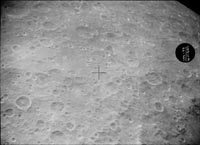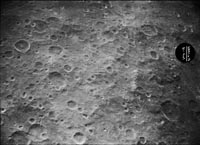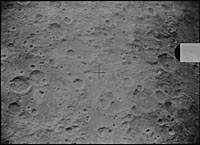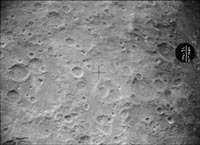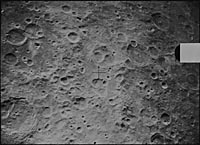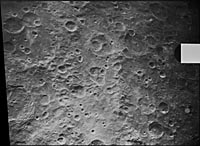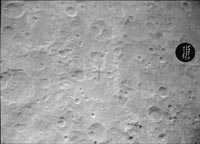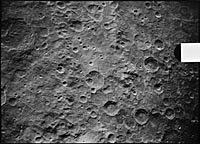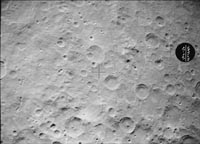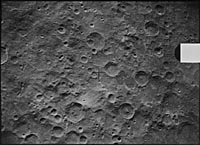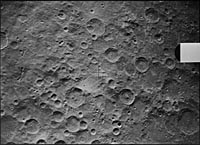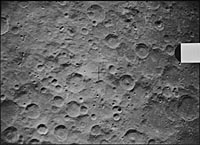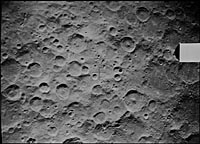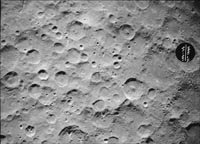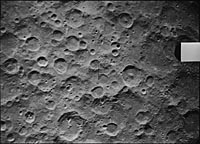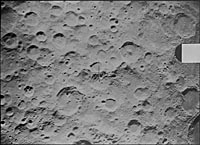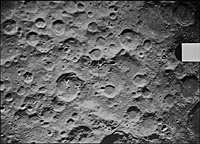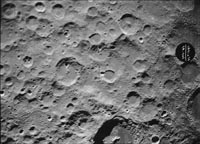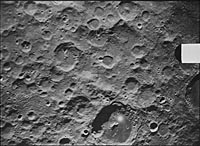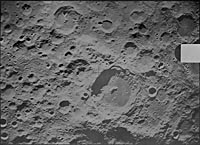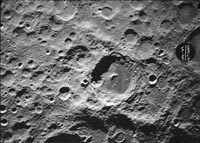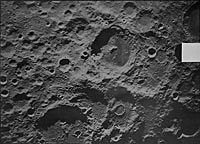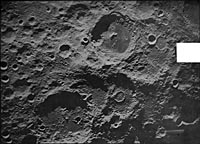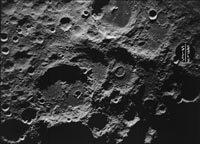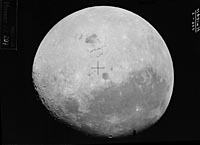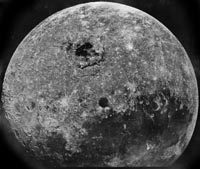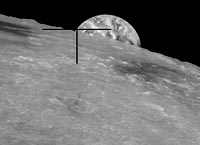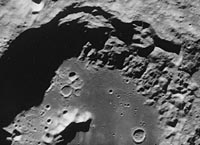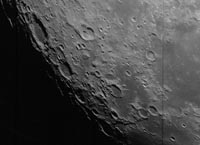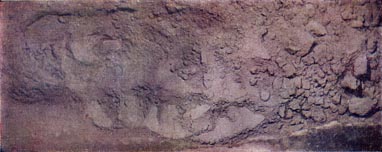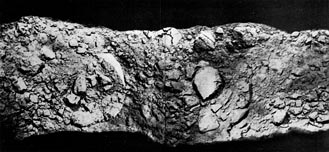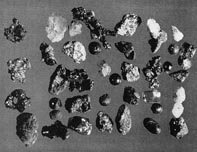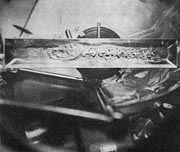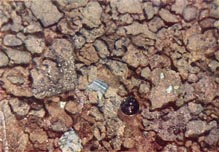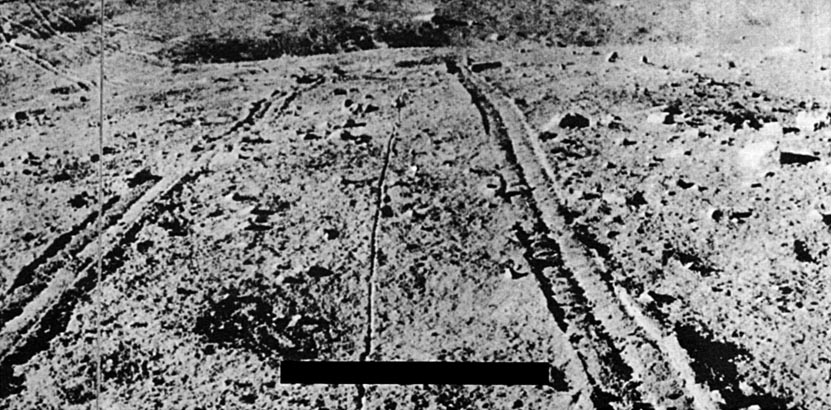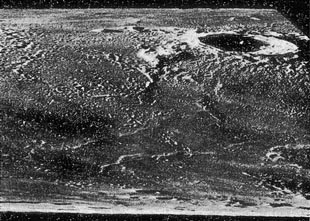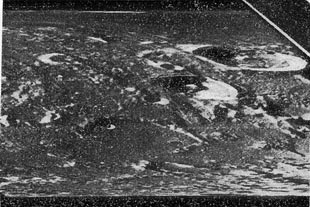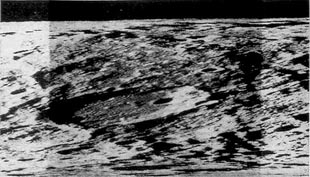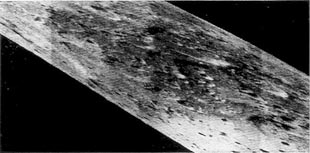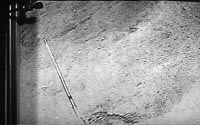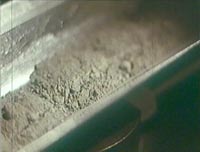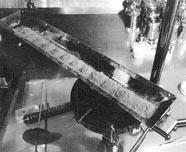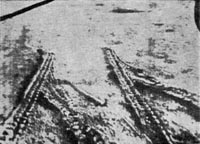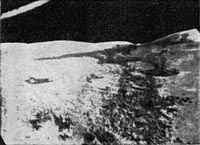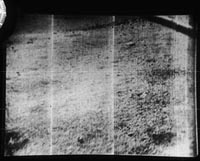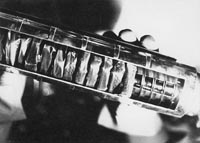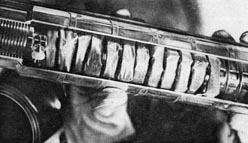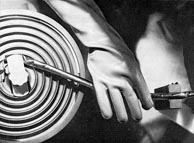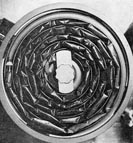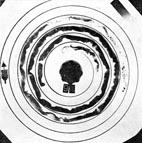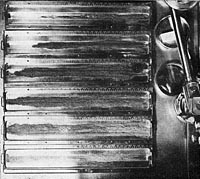Russian probes returned the first images of the Lunar far side and the first images from the Lunar surface. While a manned landing was never accomplished, the final phase of Soviet exploration included a number of impressive robotic missions, returning samples and roving the surface. (Click on images to see full-sized versions)
Luna-3On October 7, 1959, Luna-3 returned the first images of the hidden side of the Moon. Using a phototelevision camera, pairs of images were simultaneously exposed through 200mm and 500mm lenses. The Luna-3 camera was developed by P.F. Bratslavets and I.A. Rosselevich at the Leningrad Scientific Research Institute of Television. The images were processed and analyzed by Iu.N. Lipskii and his team at the Sternberg Astronomical Institute.The camera held 40 frames of film, and 15 images (frames 26 to 40) were received via frequency-modulated analog video. Frames 39 and 40 may have contained calibration patterns. The full moon appears to have very little detailed texture, because the lunar mountains and terrain casts no shadows when lit from overhead. A special thanks to Dr. Vladislav Shevchenko at the Sternberg Astronomical Institute for making scans of the original film recordings for me. Blank frames indicate images that I do not have yet:
The video signal from Luna-3 was higher quality than usually supposed. A photograph made in 1965 from the magnetic tape shows sharper detail and greater dynamic range:
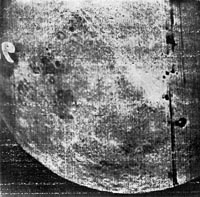
Frame 26 (1965 recording) Two types of test patterns were included on the Luna-3 film, a standard Soviet television chart and a type of zebra-stripe resolution chart called Shtrichovaya Mira. These are not actual images from Luna-3, they just illustrate what was imprinted on the film.
Zond-3One July 20, 1965, Zond-3 was the second spacecraft to view the far side of the Moon. This model 3MV spacecraft was actually designed for missions to Mars and Venus. Using a phototelevision camera, 29 frames were exposed. The Zond-3 camera was developed by A.S. Selivanov and his team at the Institute of Space Device Engineering. The images were processed and analyzed by Iu.N. Lipskii and his team at the Sternberg Astronomical Institute. Frames 1 and 2 were probably pre-exposed test patterns and have not been published, frames 8-10 contained an ultraviolet spectrum, and frame 25 was never received. Using digital pulse-position modulation, all frames were scanned and transmitted in 67-line resolution, and selected images were retransmitted at 1100-line resolution:
Luna-9On February 3, 1966, Luna-9 became the first spacecraft to land on the Moon. On February 4 and 5, it transmitted 3 cycloramic panoramas from an optical-mechanical camera. The camera was developed by A.S. Selivanov and his team at the Institute of Space Device Engineering, and the results were analyzed at the Sternberg Astronomical Institute and by A.I. Lebedinskii at Moscow University. The images were transmitted as analog FM video signals at one stroke per second over a 250 Hz subcarrier (equivalent to 500 pixels/line).The photo below, shows a section of Panorama 2 printed from a British recording of the Luna-9 signal at Jodrell Bank Radio Observatory: Luna-12Luna-12 entered orbit on October 25, 1966, carrying two phototelevision cameras of the same variety as Zond-3. This was the first Soviet craft to take close up pictures from orbit, but only a few images have ever been published:
Luna-13On December 24, 1966, Luna-13 made the second Soviet landing on the Moon. It transmitted 5 cycloramas over a period of several days (note shadows becoming less elongated).Zond-5On September 18, 1968, Zond-5 became the first spacecraft to circle the Moon and return to land on Earth. The camera systems on Zond-5 through Zond-8 were designed by a team under Boris N. Rodionov at the Moscow State University of Geodesy and Cartography (MIIGAiK). They also performed most of the analysis of the returned images. It photographed the Earth from a distance of 90,000 km, but a subsequent malfunction of the orientation system prevented it from photographing the Moon:
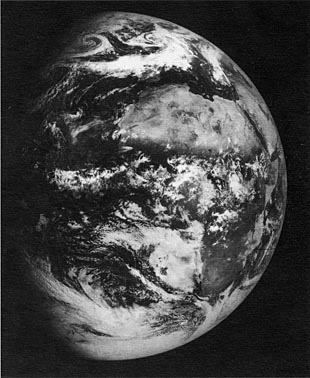
Zond-6Zond-6 flew around the Moon on November 14, 1968. It carried the AFA-BAM camera with 400 mm objecitve, shooting on 13 × 18 cm frames of isopanchromatic film. A session of 111 frames was performed at a distance of 9290-6843 km, and another session of 58 frames from 2660-2430 km.A crash landing on Earth flattened and broke open the film canister, but 52 photographs were recovered with some degree of laceration and fogging. Only a few fragments of Zond-6 images have been published. A mosaic image was constructed from the recovered imagery, shown below as the last image. Poor print quality, not film damage, is the reason for the low quality of the first and thrid image below:
Zond-7Zond-7 photographed the Earth on August 9 and performed two photo sessions at the Moon on August 11, 1969. It shot 35 pictures with the SKD camera and 300 mm objective, on 5.6 × 5.6 cm frames of color and panchromatic film:
Zond-8Zond-8 flew by the Moon on October 24, 1970 and returned to Earth with high quality photographs, some from as close as 1350 km. Images were shot with the 400 mm AFA-BAM camera, on 13 × 18 cm frames of isopanchromatic film. A session of 20 full-Moon pictures was followed by a session of 78 Lunar-surface pictures (including 17 shots of the Earth over the Lunar horizon).The images below are 20 percent of full size. Frames flagged with a star are from 6000 × 8000 pixel images digitized in Moscow from the original negatives. The remainder are from lower resolution scans of film copies in the archives of the US Geological Survey.
A few sections at full resolution show the true quality of the Zond camera system:
Luna-16Luna-16 landed in the Sea of Fertility on September 20, 1970. It had two cycloramic optical-mechanical cameras of higher light sensitivity than Luna-9, with lamps and a wide lens aperture, since this mission landed at night. The artificial illumination failed, and unpublished panoramic images are reported to contain only a few light spots seen in Earthlight.
Photos above show portions of the 101 gram sample of lunar rock and soil retuned to Earth by the spacecraft. Luna-17 with Lunokhod-1Luna-17 landed on the Moon on November 15, 1970. The robotic rover, Lunokhod-1 rolled off the landing platform to explore the surface of the Moon for about a month. Two cycloramic cameras on either side of the rover were oriented for 180° horizontal panoramas (500 × 3000 pixels). These panoramas are sometimes geometrically warped to correct for the 15° tilt of the camera.Two other cameras were oriented for 360° vertical panoramas of 500 × 6000 pixels, including images of the sky for star locations. A level indicator was placed below these cameras, with a bull's eye pattern and a small metal ball bearing. This level indicator can be seen as the "dixie cup" in the horizontal pans. Over 200 panoramas were returned. Two cameras transmitted simultaneously, on 130 and 190 KHz subcarriers. Analysis of these images was carried out by the Sternberg Astronomical Institute (SAI), the Vernadskii Geophysical Institute (GEOKhI), and the Space Research Institute (IKI). The cameras were built by Arnold Selivanov's team at RNIIKP. As with many Soviet space images, generation loss prevents us from seeing the original quality. Most Lunokhod images are derived from scanning printed images or second-generation film copies. Each stage of photography, printing and scanning introduces noise, nonlinear brighness mapping, and (worst of all) clamping to white or black. The images below only hint at the appearance of the original video signal.
Camera No. 2 (Left Side)Camera No. 4 (Right Side)Cameras No. 1 and 3 (Vertical Panoramas)It is difficult to distinguish left and right side views, and like all Lunokhod pans, publishers routinely flip the images. Selivanov identifies 01 and 08 as coming from camera no. 3. Pan 09 might be from Lunokhod-2.Video PicturesOver 20,000 low-resolution video pictures were transmitted, primarily for use by the drivers to navigate the rover. Note the usual horizontal scanlines of a TV camera, as opposed to the vertical scanlines of the cycloramic cameras.
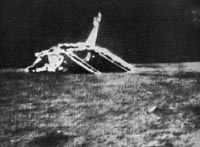
Luna-19Luna-19 was a heavy orbiter based on the Luna-17 spacecraft and a lunokhod housing. It entered a low (100 km above surface) orbit on October 3, 1971 and returned 5 panoramas scanned by two linear optical-mechanical cameras as it passed across the Moon. These panoramas scanned a 150° "fish-eye" view from horizon to horizon, at 4 strokes/second, perpendicular to the path of the spacecraft. Very few of the Luna-19 images have been published, the best image being this photo of a lunar crater:
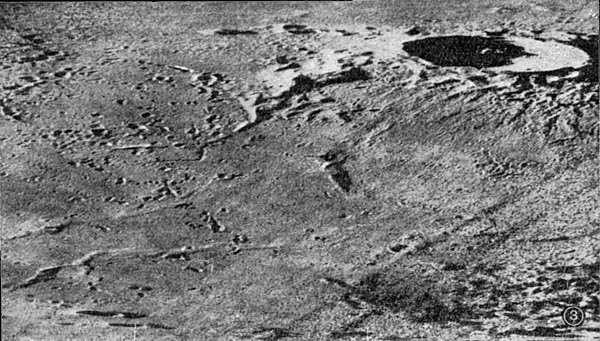
The image above is actually a cropped version of the panorama seen below left. Two poor-quality reproductions of fragments are seen below, which will hopefully be upgraded. Smaller printed fragments show the whole signal, including the square-wave retrace signal. They suggest that the camera scanned at 45° to the orbital path:
Luna-20Luna-20 landed on the Moon on February 21, 1972. Like Luna-16, it was a robotic mission that returned lunar soil to the Earth. It carried a stereo pair of optical-mechanical cycloramic cameras, working at 4 lines per second and 300 pixels per line. Angled at 50° from the vertical, these cameras returned 360° panoramas, including the lunar surface and portions of the spacecraft and sky. It also scanned the drilling site before and after sampling. Published fragments of panoramas show the soil drilling apparatus in the foreground and views of the lunar horizon to either side.

Like Luna-16, a stereo pair of cameras were included, spaced 0.5 meters apart. The view from the other camera is seen below (microfilm of a newspaper photo):
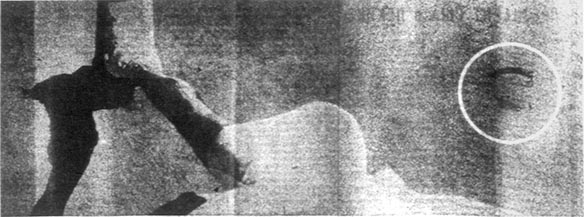
A second view of the panorama, below left, is constructed from frames of a film, as it emerges from a printer. The dark object upper left is the printer head.
Luna-20 returned 55 grams of lunar material, the first samples ever seen from the ancient Lunar highlands. It was the second attempt in that dangerous rugged terrain, landing about a mile from the crash site of its sister ship Luna-18. The anorthosite composition of the soil seen above was found again when Apollo 16 and 17 landed in highland locations later that year. Luna-21 with Lunokhod-2Luna-21 entered Lunar orbit on January 12, 1973, and landed on January 15. The robotic rover, Lunokhod-2 rolled off the landing platform to explore the surface of the Moon for about 4 months. Like Lunokhod-1, it had two vidicon television cameras for navigational control, and four optical-mechanical cycloramic cameras. It returned 86 panoramas and over 80,000 navigational video pictures. Lunokhod-2 pans don't contain a level indicator ("dixie cup") on one of the sides.
Camera No. 2 (Left Side)
Camera No. 4 (Right Side)STS CameraThe Lunokhod rovers also had two vidicon-tube television cameras mounted on the front. These returned 250-line images at 10 frames per second, for the drivers to guide the vehicle.

Sample of STS Video Sequence Luna-22Luna-22, a second heavy orbiter, reached the Moon on June 2, 1974 and operated for more than a year. To perform photo surveying of the surface, an elliptical orbit was established, coming as close as 15 to 30 km above the Lunar surface. From June 9 to 13, it returned 10 panoramas from its optical-mechanical camera, and then returned to a higher circular orbit to perform other experiments. The thin line running along the image is from a spacecraft strut protruding into the scanline of the camera. Portions of the square-wave retrace pattern can be seen in some sections, above and below the video signal. These panoramas are reconstructed from scanned photos.Two other fragments have been found, which hopefully can be upgraded with better quality images someday:

Luna-24Luna-24 was the last spacecraft to land on the Moon (Soviet or American), on August 18, 1976. Boring 2.25 meters into the Moon, it obtained a 170.1 gram core sample 1.6 meters in length. The drilling apparatus packed the sample into a 8mm diameter plastic tube, which was wound into a helical container. At the Vernadsky Institute, the core was initially transfered to a flat spiral container to be x-rayed, then transfered to a series of trays.Luna-24 did not carry cycloramic cameras. Photos of the returned sample are shown below:
AcknowledgementsThanks to Phil Stooke for Luna-12, 13, 20, 22 and Zond-6, 8 photos, scanned at IKI and MIIGAiK in Moscow. Thanks to Alexander Basilevsky and Arnold Selivanov for information about Luna-16, 20 and 24 missions and imagery. Thanks to Don Davis for some high quality Zond-7 scans. Thanks also to Sergei Hlynin for Luna-12 and 19 images.Luna-3 and Zond-3 frames and spectra were gathered from various sources, including inverse halftoning and processing of images published in Atlas Obratnoi Storony Luny. Luna-9 and 13 images were similarly processed from sources including Pervye Panoramy Lunnoi Poverkhnosti and an extra fragment supplied by Phil Stooke from another source. Lunokhod images were published by the Sternberg Astronomical Institute, and others supplied by Phil Stooke and in Peredvizhnaia Laboratoriia na Lune Lunokhod-1. |
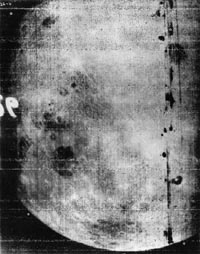
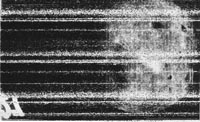
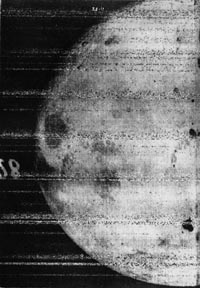
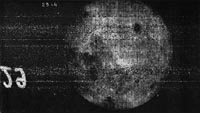

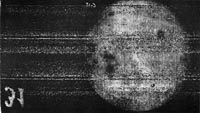
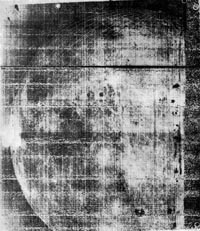
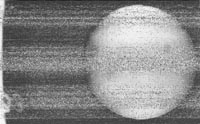
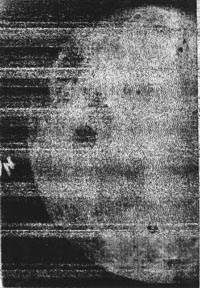
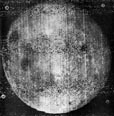
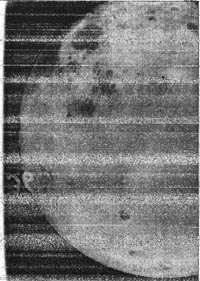

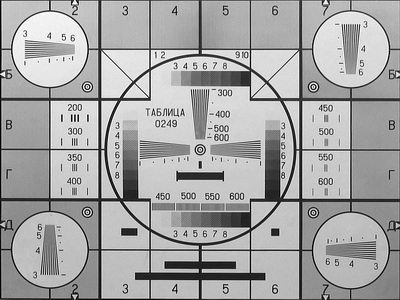 Television Test Card 0249
Television Test Card 0249
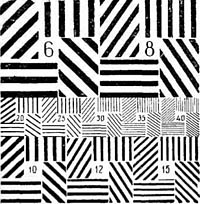 Shtrichovaya Mira
Shtrichovaya Mira
